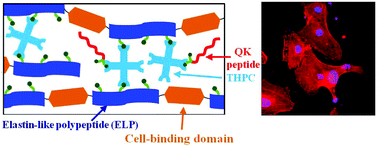One-pot synthesis of elastin-like polypeptide hydrogels with grafted VEGF-mimetic peptides
Abstract
Immobilization of growth factors to polymeric matrices has been a common strategy in the design of tissue engineering scaffolds to promote tissue regeneration, which requires complex cell signaling events with the surrounding matrix. However, the use of large protein growth factors in polymeric scaffolds is often plagued by immunogenicity, short in vivo half-lives, and reduced bioactivity. To address these concerns, we developed a single-step, cell-compatible strategy to tether small, growth-factor-mimetic peptides into a protein-engineered hydrogel with tunable biomaterial properties. Specifically, we covalently immobilized the QK peptide, an angiogenic peptide mimicking the receptor-binding region of vascular endothelial growth factor (VEGF), within tunable elastin-like polypeptide (ELP) hydrogels that include a cell-adhesive RGD sequence. Using a cell-compatible, amine-reactive crosslinker, we conducted a one-pot synthesis to simultaneously encapsulate cells while precisely controlling the QK grafting density (10 nM–100 μM) in the ELP hydrogels without altering other material properties. Fluorescence analysis of fluor-labeled QK peptides demonstrated that the conjugation efficiency to ELP hydrogels was >75% and that covalent immobilization effectively eliminates all QK diffusion. Compared with pristine ELP hydrogels, human umbilical vein endothelial cell (HUVEC) proliferation was significantly enhanced on ELP hydrogels immobilized with 10 nM or 1 μM QK. Moreover, upon encapsulation within tethered QK-ELP hydrogels, HUVEC spheroids maintained near 100% viability and demonstrated significantly more three-dimensional outgrowth compared to those supplemented with soluble QK peptide at the same concentration. These results encourage the further development of protein-engineered scaffolds decorated with growth-factor-mimetic peptides to provide long-term biological signals using this versatile, single-step synthesis.

- This article is part of the themed collection: Emerging Investigators

 Please wait while we load your content...
Please wait while we load your content...